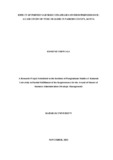| dc.description.abstract | The study sought to look at the effect of Porter’s generic strategies on firm performance of Tyre dealers within Nairobi County. Tyre demand remains high in the country owing to the high motorization rate of the population in Kenya. This demand creates good opportunities to dealers who would then develop strategies to be the biggest satisfiers of this demand. In pursuit of this competitive edge, firms adopt different strategies to enhance performance in terms of high volumes, revenue and profitability. The study sought to analyze the effect of cost leadership, differentiation and focus strategies on firm performance. This study has its foundation grounded on Porter’s generic strategies theory as the guiding theory. The study adopted a descriptive research design. The population of the study were 300 Tyre dealers in Nairobi County. A sample of 200 Tyre dealers was picked through purposive sampling in Nairobi County. Out of the targeted Tyre dealers picked through purposive sampling, 108 were responsive indicating 54% response rate, this large sample ensured the reliability of the responses while the mode of structure of the questionnaires guaranteed the validity of the data collected. The Cronbach alpha measure was used to test reliability and internal consistency of the questionnaires with a strong co-efficient of 0.98, 0.99 and 0.97 respectively for cost leadership, differentiation and focus strategy questionnaires respectively. Questionnaires were dropped to 200 Tyre dealers and later picked. Data obtained was analyzed in accordance with the objectives of the study, which was to assess the effect of Porter’s generic strategies on firm performance specifically on sales revenue, sale volume, profitability and firm expansion, among Tyre dealers. Data analysis was done through content analysis, measures of central tendency, frequency tables, relative percentages, and regression analysis. Given the sensitive nature of information sought from the Tyre dealers, an assurance on confidentiality was given. After analysis of the data through multiple regression, it was deduced that 95.2% of firm performance was attributed to cost leadership, differentiation and focus strategies based on the regression model. Based on the regression model cost leadership deduced a coefficient of 0.84 implying that an increase in a unit of firm performance due to an increase in 0.84 unit of cost leadership. Differentiation generated a co-efficient of 0.09 implying increase in one unit of performance due to an increase in 0.09 unit of differentiation Focus strategy deduced a co-efficient of -0.05 implying a reduction of a unit of performance by an increased in practice of focus by 0.05. This overall indicated that cost leadership and differentiation have a positive effect on performance while focus strategy has a negative effect on firm performance. Business organizations can use the findings of this research to tailor their business strategies along cost leadership and differentiation as strategies that affect positively on business performance. | en_US |

